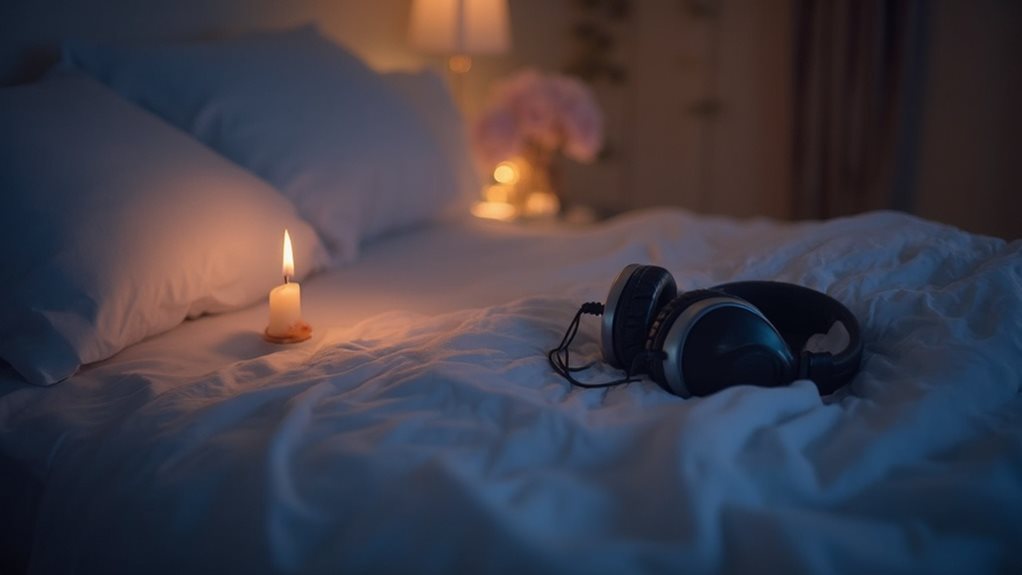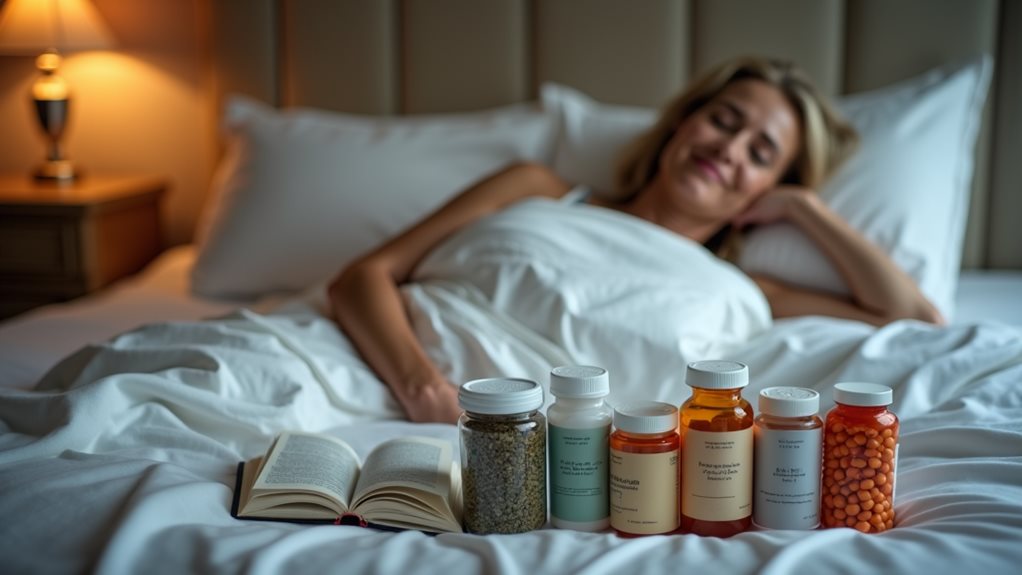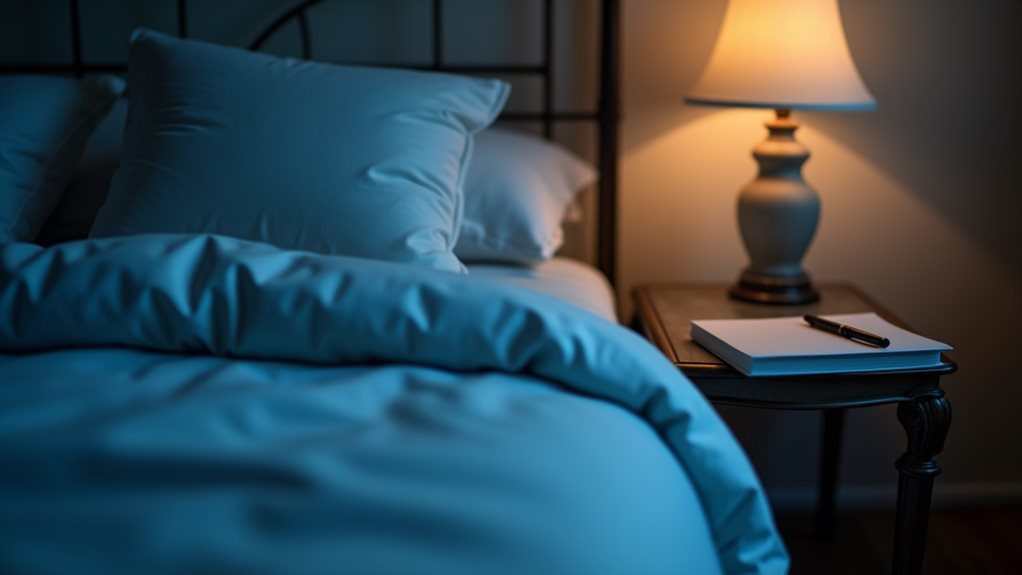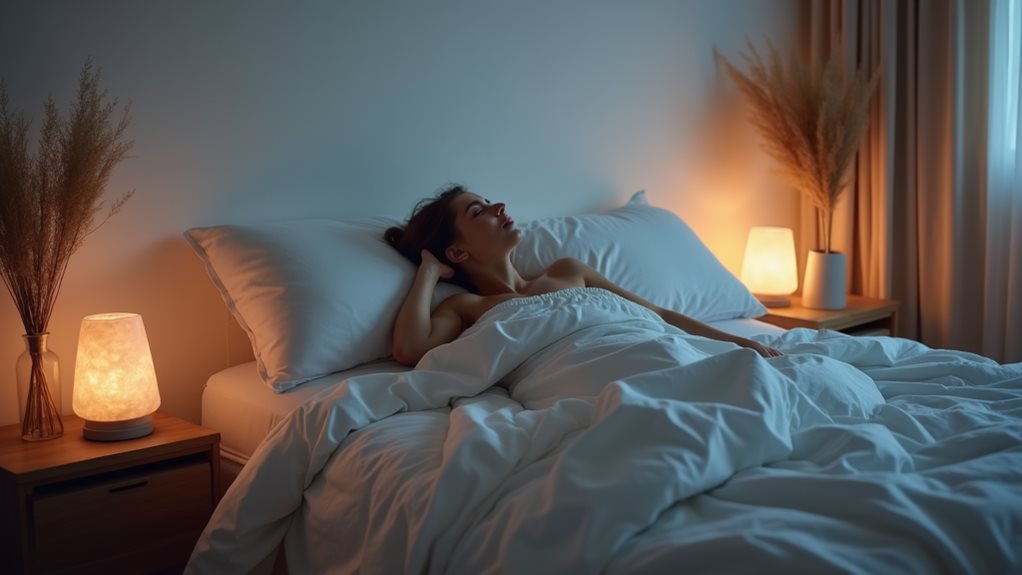
Self-hypnosis empowers individuals struggling with insomnia to tap into their subconscious, facilitating a transformative reprogramming that promotes healthier sleep patterns and mental relaxation. Techniques such as guided imagery, deep breathing, and progressive muscle relaxation are central to this approach, offering a personalized and effective alternative to traditional sleep medications. With regular practice, one can greatly enhance sleep quality, discovering a path to restful nights and energetic days. For a deeper understanding, more insights follow below.
Key Takeaways
- Master deep breathing and progressive muscle relaxation techniques to induce a trance-like state conducive to sleep.
- Use guided imagery to visualize calming scenarios, enhancing mental relaxation before bedtime.
- Incorporate positive sleep affirmations into your routine to reprogram subconscious sleep patterns.
- Ensure regular practice of self-hypnosis to progressively improve sleep quality and consistency.
- Monitor your sleep improvements with a daily journal and adjust techniques as needed for optimal results.
The Science Behind Sleep Hypnosis
Sleep hypnosis operates on the principle of reprogramming the subconscious mind, a technique that has garnered scientific interest for its potential to improve sleep quality.
Neuroscience insights reveal that during sleep hypnosis, targeted suggestions can effectively modify subconscious patterns that disrupt sleep. This process encourages the brain to adopt healthier sleep behaviors and attitudes, making it a profoundly transformative tool for those struggling with insomnia.
Key Techniques for Effective Self-Hypnosis
To effectively harness the power of self-hypnosis for improved sleep, one must first master key techniques that facilitate a deep, trance-like state.
Incorporating guided imagery, individuals visualize peaceful scenes, such as a tranquil beach or a quiet forest, which promote mental relaxation. This visualization is bolstered by relaxation techniques, including deep breathing and progressive muscle relaxation, easing the body into a state of profound calmness.
These methods work synergistically to access the subconscious, making it receptive to positive sleep-inducing suggestions. Regular practice of these techniques cultivates a routine that enhances the quality of sleep over time.
Comparing Self-Hypnosis With Conventional Sleep Treatments

While self-hypnosis provides a unique and personalized approach to combating insomnia, it stands in contrast to conventional sleep treatments such as pharmacotherapy and medical interventions.
Self-hypnosis benefits include the empowerment of individuals to actively manage their sleep patterns, minimizing reliance on medications and their potential side effects.
In this sleep treatment comparison, self-hypnosis emerges as a cost-effective, drug-free alternative that can be tailored to address specific psychological factors influencing sleep disturbances.
It emphasizes deep relaxation and mental reprogramming, offering a compassionate and effective solution for those seeking control over their sleep without the constraints of traditional medical approaches.
Personalizing Your Self-Hypnosis Routine
How can one tailor self-hypnosis to fit personal sleep needs effectively?
Personalizing one's self-hypnosis routine is key to enhancing sleep quality through techniques that resonate deeply with individual preferences and challenges. Here are some strategies:
- Identify specific sleep issues to address with targeted custom affirmations.
- Utilize visualization techniques to imagine peaceful, restful scenarios.
- Experiment with different voice tones and pacing in guided suggestions.
- Adjust the session duration to match personal relaxation needs and nightly routine.
Safety and Monitoring Progress With Self-Hypnosis

Although self-hypnosis is generally regarded as a safe practice, it is important for practitioners to monitor their progress and be aware of any potential adverse reactions. Utilizing self-reflection techniques and tracking progress can enhance the efficacy of self-hypnosis for improving sleep quality. This monitoring can be achieved through structured reflection and the use of sleep journals, ensuring a safe and positive experience.
| Aspect | Technique | Purpose |
|---|---|---|
| Self-Reflection | Daily Sleep Journals | Identify Patterns & Triggers |
| Progress Tracking | Weekly Progress Reviews | Assess Improvement |
| Safety Monitoring | Regular Self-Assessments | Detect Adverse Reactions |
These tools promote a safe, informed, and adaptive approach to self-hypnosis.
Success Stories: Real-Life Transformations
Monitoring the safety and progress of self-hypnosis not only guarantees a controlled approach to managing insomnia but also sets the stage for hearing about those who have experienced tangible benefits from this practice.
These transformation testimonials not only inspire but reassure others of the potential self-hypnosis holds:
- Mark: Overcame chronic insomnia, now enjoys 7 hours of sleep.
- Linda: Reduced anxiety-induced sleeplessness, reports heightened daytime energy.
- Raj: Escaped medication dependency, finding natural sleep through nightly routines.
- Sophie: Improved overall well-being by resolving sleep disturbances.
These success reflections highlight the profound and personal changes possible with dedicated self-hypnosis practice.
Daily Integration of Self-Hypnosis Practices

Integrating self-hypnosis into daily routines can be a transformative practice for individuals struggling with sleep disturbances. Establishing a regular schedule for self-hypnosis guarantees consistency, which is key to its effectiveness.
By setting daily reminders, individuals can incorporate these practices seamlessly into their life. Integrating rituals, such as dimming lights or playing soft music, can enhance the hypnosis experience, making the shift into a relaxed state more natural.
This daily commitment not only improves sleep quality but also empowers individuals by embedding positive sleep habits. Such dedicated practice fosters a deeper connection to one's own mental and emotional needs.
Leveraging Self-Hypnosis to Revolutionize Your Sleep Health
By harnessing the power of self-hypnosis, individuals can fundamentally transform their approach to sleep health, establishing a foundation for deeper, more restorative rest.
This mindful practice offers several benefits:
- Enhances the sleep environment by fostering a tranquil mindset, essential for relaxation.
- Integrates mindfulness techniques, aiding in the reduction of sleep-interrupting thoughts.
- Promotes consistent sleep patterns by aligning the subconscious with healthy sleep habits.
- Offers a non-invasive approach, allowing for a gentle yet effective journey towards improved sleep.
Adopting self-hypnosis can revolutionize one's nightly routine, turning troubled sleep into a peaceful escape.
Frequently Asked Questions
How Quickly Can One See Results From Self-Hypnosis for Sleep?
Results from self-hypnosis for sleep vary; some individuals experience improvements within a few days, while others may need weeks of consistent practice with self-hypnosis techniques to observe significant changes in their sleep patterns.
Can Self-Hypnosis Help With Sleep Issues Besides Insomnia?
Self-hypnosis casts a gentle net of relaxation over troubled waters, enhancing sleep quality beyond mere insomnia. Its techniques soothe various sleep disturbances, offering a comforting, effective beacon of rest for weary minds.
Is Self-Hypnosis Safe for Pregnant Women?
Self-hypnosis is generally considered safe for pregnant women, offering benefits like reduced anxiety and improved sleep. However, it's advisable to consult healthcare providers to tailor practices safely during pregnancy.
Are There Age Restrictions for Practicing Self-Hypnosis?
Like a garden grows at its own pace, self-hypnosis suits various ages with no strict age restrictions, but age suitability and child development considerations guide its application, ensuring it's adapted empathetically and informatively for each individual.
Can Self-Hypnosis Permanently Cure Sleep Disorders?
Self-hypnosis techniques may not permanently cure sleep disorders but can greatly improve sleep quality. Consistent practice offers long-term effectiveness, providing a reassuring, non-invasive option for managing sleep issues empathetically and informatively.
Conclusion
To sum up, self-hypnosis emerges as a gentle beacon in the night for those struggling with sleep disruptions. As the saying goes, "A well-spent day brings happy sleep." This technique empowers individuals to reclaim their nights, fostering a sense of control and tranquility. By integrating self-hypnosis into their nightly routine, many find a pathway to not just better sleep, but a more harmonious life. This empowering tool reassures and revitalizes, offering a serene retreat from the chaos of insomnia.





